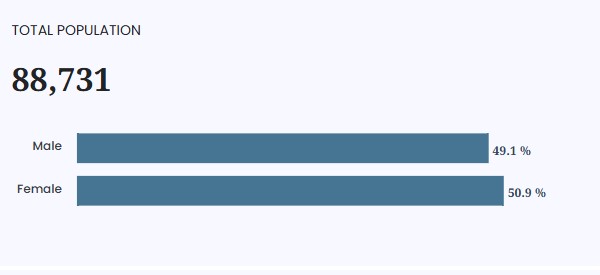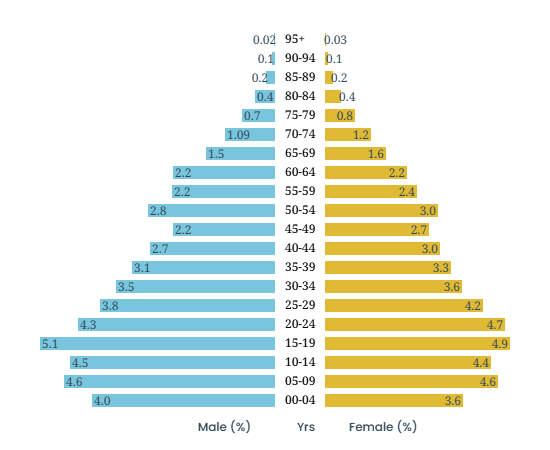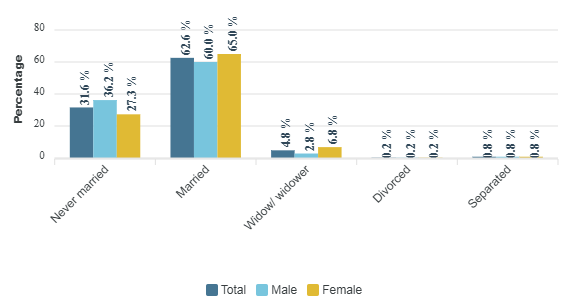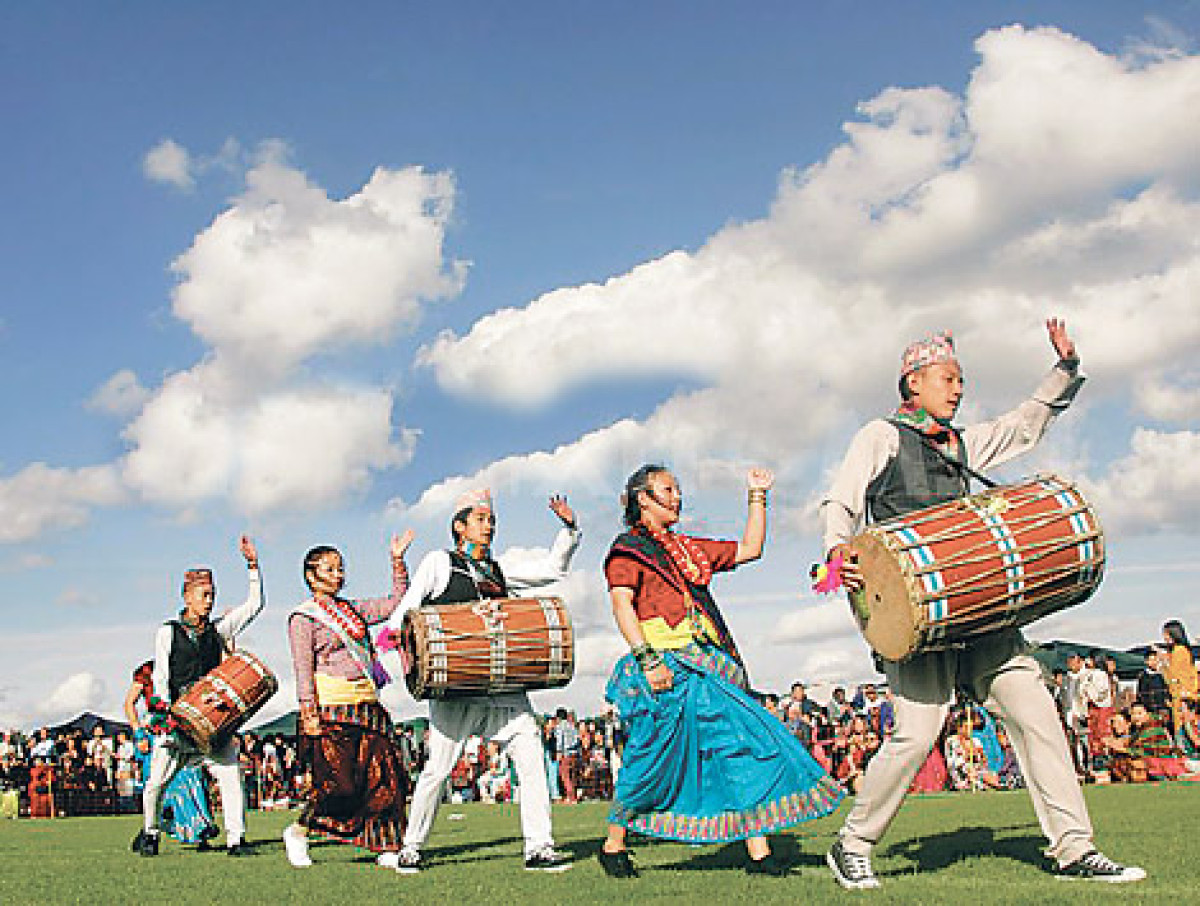

Nestled in the heart of Nepal’s Koshi Province, Tehrathum District is a hidden gem that promises travelers a blend of natural beauty, cultural richness, and spiritual serenity. Despite being a small district with a total area of just 679 square kilometers, Tehrathum offers an abundance of picturesque landscapes, diverse ecosystems, and historical landmarks that make it an increasingly popular destination for tourists.
Geographical Diversity and Accessibility
Tehrathum is strategically located in the eastern part of Nepal, bordered by Taplejung and Panchthar to the east, Dhankuta and Sankhuwasabha to the west, Taplejung and Sankhuwasabha to the north, and Dhankuta and Panchthar to the south. The district headquarters, Myanglung, sits at an altitude of 1,665 meters above sea level, offering a mild climate throughout the year. The varied terrain, ranging from lush green lowlands to the snow-covered ridges of the Himalayas, ensures that there is something for every type of traveler.
The district is well-connected by roads, making it accessible for both domestic and international visitors. Whether you’re driving through the hilly terrain or trekking through serene valleys, Tehrathum’s landscape offers plenty of opportunities to take in the natural beauty of Nepal. The district’s proximity to Kangchenjunga and Makalu makes it an ideal spot for those seeking to explore some of the world’s tallest peaks without the crowds of more famous trekking regions.
Tehrathum District is home to six local level governments (municipalities and rural municipalities). These are:
Laligurans Municipality
Phedap Rural Municipality
Menchhayayem Rural Municipality
Chhathar Rural Municipality
Aaathrai Rural Municipality
Myanglung Municipality
Nestled at the crossroads of the Mid-Hill Highway and Koshi Highway, Laligurans Municipality is a beautiful and diverse destination waiting to be explored. Located in the eastern region of Nepal within Koshi Province, Laligurans is a stunning fusion of natural beauty, rich culture, and remarkable landscapes.
Formerly known for the charming villages of Basantpur, Phulek, Solma, Sungnam, and Dangpa, Laligurans is now an officially recognized municipality, offering visitors the perfect escape from the bustle of city life. Whether you’re an avid traveler, adventure seeker, or nature lover, this area is a treasure trove of scenic spots.

Total Population of Terhathum district. (Source: National Population and Housing Census 2021)
Laligurans is not only famous for its picturesque views, but it’s also strategically located as a gateway to the Terai region from Sankhuwasabha, Taplejung, and Tehrathum districts. The municipality stretches across diverse landscapes, from lush valleys to towering hills, making it an ideal spot for trekking and hiking.
With an area of 90.27 square kilometers, Laligurans offers something for everyone. The altitude varies from 560 meters in the lower valleys to 3065 meters in the higher hills, allowing visitors to experience a range of climates as they travel through the region. You’ll find subtropical climates at the base, transitioning into temperate climates as you climb the hills, and a cool, refreshing atmosphere at the top of the mountains. This variation makes it a year-round destination, each season offering unique experiences.
Laligurans Municipality is home to diverse flora and fauna, with vibrant forests and lush greenery that make it an enchanting place for nature lovers. The Pingwa River marks the eastern boundary, while the watershed hills of Dhankuta District separate it from other regions. The rich biodiversity in the area, coupled with its climate variety, makes it a perfect spot for bird watching and wildlife enthusiasts.
Explore the history and culture of the region as you visit traditional villages and interact with the local communities. With a mix of subtropical, warm temperate, and cool temperate climates, the area hosts a variety of agricultural products, from tea plantations to staple crops. You can enjoy the hospitality of the local people while tasting authentic Nepali dishes and exploring the traditional way of life.
Laligurans Municipality is more than just a natural beauty; it is also an adventure hub. The confluence of different highways and its strategic location makes it an ideal starting point for trekking and hiking to nearby districts like Sankhuwasabha and Tehrathum. If you’re into adrenaline-pumping activities like mountain biking, nature walks, or river rafting, the diverse landscape offers plenty of opportunities.
If you seek peace and serenity, the quiet valleys and hills of Laligurans will soothe your soul. For those looking for more adventure, the rugged hills and fast-flowing rivers promise an unforgettable experience. Whether you’re a solo traveler, a couple seeking a romantic retreat, or a family eager to discover the beauty of Nepal, Laligurans is the place to be.
Nestled in the eastern-central part of Tehrathum District within Koshi Province, Phedap Rural Municipality is a stunning destination waiting to be explored by nature lovers, adventurers, and cultural enthusiasts alike. This peaceful rural area, rich in natural beauty and cultural diversity, offers an authentic experience that captures the heart of eastern Nepal.
Phedap is a picturesque haven with lush forests, rolling hills, and serene rivers that create an idyllic backdrop for travelers seeking a peaceful escape. Whether you’re trekking through the stunning landscapes or simply enjoying the tranquility of the surrounding nature, this rural municipality offers an unmatched opportunity to connect with Nepal’s diverse landscapes.
The region was formed by merging five Village Development Committees (VDCs): Simle, Oyajung, Jaljale, Samdu, and Isivu. Each area contributes its unique charm to the municipality, offering an intricate blend of nature and tradition.
Phedap is home to a variety of ethnic groups, including the Limbu, Rai, Tamang, Chhetri, Damai, Kami, Sarki, Bhujel, Jogi, Sanyasi, Puri, Maji, and Magar communities. This diversity is reflected in the vibrant festivals, customs, and traditional practices that make Phedap an unforgettable cultural experience. Visitors can immerse themselves in the rich traditions, savor authentic local dishes, and participate in the lively celebrations that showcase the heritage of each ethnic group.

Population by sex and 5-year age group in Terhathum district. (Source: National Population and Housing Census 2021)
For adventure seekers, Phedap offers numerous opportunities to explore its breathtaking natural surroundings. The rolling hills and dense forests are perfect for trekking, hiking, and nature walks, where visitors can enjoy panoramic views of the Himalayan foothills and observe a variety of bird species. The region’s diverse climate and geography make it an ideal destination for eco-tourism.
The rivers and streams that flow through Phedap also offer options for activities like fishing and nature exploration. Whether you’re trekking to the top of a hill or exploring the dense forests, the journey through Phedap is one filled with natural wonders.
Phedap is committed to sustainable tourism, making it an excellent destination for travelers who wish to explore a place that is both environmentally conscious and culturally rich. The community-driven tourism initiatives in Phedap ensure that visitors can enjoy an authentic experience while also contributing to the local economy.
For those seeking solace and rejuvenation, Phedap provides the perfect setting. The peaceful environment, away from the hustle and bustle of city life, is ideal for meditation, relaxation, and immersing oneself in nature. The scenic beauty, combined with the warm hospitality of the local people, makes it a perfect retreat for those looking to unwind and recharge.
As Nepal’s tourism sector continues to grow, Phedap Rural Municipality is emerging as a hidden gem for travelers looking for a more authentic and off-the-beaten-path experience. With its captivating landscapes, rich cultural heritage, and welcoming communities, Phedap is a place that promises unforgettable memories.
Nestled in the northeastern part of Tehrathum District, Menchhyayem Rural Municipality in Koshi Province is a captivating blend of natural beauty, cultural heritage, and historical charm. Spanning 70.09 square kilometers, this picturesque region offers travelers an escape into the heart of the Himalayas, with diverse landscapes, tranquil settings, and vibrant local traditions.
The area is known for its breathtaking geography, featuring highlands, rivers, valleys, and lush forests, including the famed Laligurans jungle. The landscape provides ample opportunities for nature lovers to explore, whether through hiking, wildlife spotting, or simply soaking in the scenic beauty. From towering hills to serene rivers, Menchhyayem promises a serene escape in nature.
The name “Menchhyayem” is rooted in local legends. It is said to be derived from the words “Menchhaya” and “Yep,” linked to Menchhyayem Hill, a landmark that stands at the confluence of Tehrathum, Sankhuwasabha, and Taplejung districts. Over the centuries, this hill has become a symbol of spiritual and cultural significance, intertwining local customs and rituals that visitors can experience firsthand.
Menchhyayem is not just a natural haven—it also boasts rich history and culture. The region is home to historical landmarks such as the ancient Tenahang King’s palace and the revered Gokhuri Dham, a sacred religious site. These sites not only attract those interested in history but also offer a deep cultural experience, where visitors can learn about the region’s spiritual practices and customs.
The municipality is home to a diverse community. While the majority of the population is Limbu, there are also Brahmin, Chhetri, Rai, Gurung, Bhujel, Sherpa, Tamang, Kami, and Damai communities. This mix of ethnicities and languages gives Menchhyayem its distinct character, and visitors can immerse themselves in local festivals, food, and traditions.
Geographically, Menchhyayem ranges from 1,652 meters at Morahang Bazaar to 2,900 meters at Menchhyayem Hill, offering various activities like trekking, birdwatching, and river walks. The area’s fertile land is supported by an average annual rainfall of 2,090 millimeters, which helps maintain lush greenery and a vibrant environment.

Sex ratio, population density, and annual population growth rate in Terhathum district. (Source National Population and Housing Census 2021)
Menchhyayem is also known for its rich forest resources. The region has 22 community forests that benefit local households and play an essential role in the local economy. These forests, along with rivers like Khorunga and Iwa, contribute to the municipality’s ecological significance and offer travelers a chance to enjoy its natural wonders.
Nestled in the serene mid-hill region of Tehrathum District, Chhathar Rural Municipality offers an extraordinary blend of natural beauty and rich history. Located in Koshi Province, eastern Nepal, Chhathar is a place where the past and present seamlessly come together to create a truly captivating destination for travelers. Its moderate climate and diverse geography provide the perfect backdrop for exploration and adventure.
Chhathar is steeped in history, with the name believed to come from the word “Thangtharu,” meaning “battle ceased.” This historical significance adds to its allure, as the region was once one of the 17 prominent Thums of eastern Nepal. Around 1867, the Khiewahang people, an ethnic group from Limbuwan, defined the region’s identity, and thus the name Chhathar was born.
As you explore Chhathar, you’ll be immersed in the charm of its varied landscapes, from lush valleys to high hills. The region is bordered by the vibrant Laligurans Municipality and Myanglung Municipality to the north, Panchthar District to the east, and Dhankuta District to the south and west, making it a central point for discovering the beauty of eastern Nepal.
Stretching over 133.93 square kilometers, Chhathar Rural Municipality is home to about 14,197 residents, who live in six wards formed by merging the former Village Development Committees (VDCs) of Angdim, Hamrajung, Panchakanya, Phakchamara, Okhre, and Sudap. The diverse cultural heritage of the local people, including ethnic groups such as the Khiewahang, Limbu, and Rai, is evident in their daily lives, festivals, and customs.
The landscape of Chhathar ranges from 322 meters to 2,550 meters above sea level, offering spectacular views of both lowland and highland scenery. The central area of the municipality sits at 1,920 meters above sea level, providing a perfect spot to soak in the panoramic beauty of the region. The central office is located in Hamrajung, which became the heart of this vibrant municipality following its establishment in 2017.
For adventure enthusiasts, Chhathar offers a blend of trekking, nature walks, and cultural exploration, all set within a tranquil environment. Whether you are a history buff fascinated by the ancient origins of this place, a nature lover seeking to explore the lush hills and valleys, or a cultural traveler wishing to experience the diverse traditions of the local ethnic groups, Chhathar has something special for every kind of traveler.
The combination of rich history, scenic landscapes, and cultural diversity makes Chhathar Rural Municipality a hidden gem that promises to enchant visitors and leave them with unforgettable memories of Tehrathum’s serene beauty.
Nestled in the picturesque Tehrathum District of Koshi Province, Aatharai Rural Municipality is a stunning destination for nature lovers, history enthusiasts, and cultural explorers. Known for its diverse geography, rich cultural heritage, and agricultural potential, Aatharai offers a unique blend of experiences that make it an exceptional spot for travelers seeking adventure and authenticity.
Aatharai is renowned for its breathtaking landscapes. The region is characterized by mountainous terrain, winding rivers, lush valleys, and terraced fields. The famous Tamor River forms the boundary to the east, while the stunning Koyakhola River marks the western boundary. The region’s natural beauty is enhanced by its highlands and fertile agricultural land, making it an ideal location for eco-tourism and outdoor activities such as trekking, fishing, and birdwatching.

Marital status in Terhathum district. (Source: National Population and Housing Census 2021)
Cultural diversity is one of Aatharai’s defining features. The region is home to multiple ethnic groups, but it is particularly famous for its Limbu community, whose culture is deeply embedded in the area’s traditions and way of life. Visitors can immerse themselves in the vibrant festivals, dances, and music of the Limbu people, such as the traditional Tamang Selo and Dhan Nach. The area is also known for its unique handicrafts, including the iconic Aatharai khukuri, khadi cloth, and the renowned Dhaka hat, which are popular souvenirs for travelers.
The name “Aatharai” has an intriguing historical significance. According to local legends, the area was named after eight Rai chiefs who, during a journey from Dharan, stopped at Sankranti Danda to rest. As they spent the night there, they decided to rule over the land, thus establishing their reign. Over time, the area became known as “Aatharai,” reflecting the influence of the Rai leaders. This historical connection adds an extra layer of intrigue for visitors interested in the region’s rich past.
The local economy thrives on agriculture, with the region being a major producer of cardamom, a globally recognized spice. Aatharai’s rich biodiversity and fertile land create perfect conditions for growing crops and raising livestock. The area’s agricultural products are a major draw for tourists looking to explore rural Nepal.
Aatharai is a culturally rich and historically significant area that offers a rare combination of natural beauty, authentic experiences, and cultural diversity. Whether you are a history buff, a nature enthusiast, or someone seeking to immerse yourself in local traditions, Aatharai Rural Municipality promises an unforgettable journey. With its pristine landscapes, vibrant festivals, and warm-hearted locals, Aatharai is a must-visit destination for those looking to explore the heart of eastern Nepal.
Myanglung Municipality, located in Tehrathum District of Koshi Province, is a charming and culturally rich destination that offers visitors a blend of natural beauty, vibrant local culture, and historical significance. Officially inaugurated on May 19, 2014, following the integration of six former village development committees—Myanglung, Tamphula, Sabla, Piple, Jirikhimti, and Ambung—this municipality serves as a prominent hub in the eastern region of Nepal.
Covering an area of 100.21 square kilometers, Myanglung Municipality is geographically diverse and stunning. It is bordered by Khorungakhola to the east, Pigwa Khola to the west, Sankhuwasabha District to the north, and the Tamor River, which forms the boundary with Panchthar District to the south. The municipality’s varied terrain includes lush forests, terraced fields, rivers, and valleys, making it an ideal location for trekking, nature walks, and outdoor activities.
The natural beauty of Myanglung is complemented by its cultural heritage. The area is home to several ethnic communities, including the Limbu, Rai, Brahmin, Chhetri, and others. These communities contribute to a rich cultural tapestry, with their own traditions, festivals, and customs. Visitors can experience the unique dances, music, and festivals of the Limbu people, as well as enjoy the delicious local cuisine. Myanglung Municipality is also historically significant.
The municipality serves as the administrative and cultural center of the region, with the municipal office located in the heart of Myanglung.
With a population of approximately 18,750, Myanglung is a bustling yet serene destination. It’s an excellent place to explore Nepal’s rural life, witness traditional craftsmanship, and interact with the warm and welcoming locals. Myanglung also holds a strategic location, as it serves as a gateway to the rest of Tehrathum and nearby districts.
The region’s diverse geography and climate provide a wide range of opportunities for ecotourism, with activities such as birdwatching, hiking, and cultural tours. The surrounding forests, rivers, and mountains are perfect for adventure enthusiasts seeking a connection with nature.
For those interested in local agriculture, Myanglung is known for its cardamom plantations and fertile lands, adding a unique element to its tourism offerings. Visitors can explore the local farms, learn about the cultivation process, and even purchase fresh produce as souvenirs.

The average age of first marriage in Terhathum District. (Source: National Population and Housing Census 2021)
Whether you’re seeking cultural immersion, outdoor adventure, or simply a tranquil retreat, Myanglung Municipality promises an unforgettable experience. Its stunning landscapes, vibrant culture, and rich history make it a must-visit destination for travelers exploring the beauty of eastern Nepal.
Cultural Richness and Ethnic Diversity
Tehrathum’s population is as diverse as its landscapes. The district is home to various ethnic groups, with Limbu people making up 35% of the population, followed by Chhetri (19%), Brahmin (16%), and other ethnic groups (30%). The primary language spoken here is Nepali, but Limbu is also widely spoken, with about 32.77% of the population using it as their first language. This cultural diversity is reflected in the festivals, customs, and traditions that are celebrated in the district.
Before Nepal’s unification in the 18th century, Tehrathum was part of the Kirat Limbuwan Kingdom. During the unification campaign of King Prithvi Narayan Shah, the region was integrated into Nepal in 1831 BS after a treaty was signed between the Gorkhali army and the Limbu people. This historical significance is still visible today in the cultural practices of the indigenous groups, particularly the Limbu community, which holds a strong influence over the area’s social and cultural life.
Natural Beauty: Tehrathum’s Scenic Attractions
Tehrathum is blessed with some of the most breathtaking landscapes in Nepal. The district’s lush green hills, towering mountain peaks, crystal-clear rivers, and verdant tea gardens make it a haven for nature lovers, trekkers, and adventure enthusiasts.
Teenjure Himal: The Majestic Peak
One of the most notable attractions in Tehrathum is Teenjure Himal, a striking peak that stands proudly in the region. A visit to this location offers some of the most incredible views in all of Nepal. From the summit, you can gaze upon the awe-inspiring Kangchenjunga and Makalu Himal—two of the world’s tallest mountains. The hike to Teenjure Himal is an adventure in itself, as visitors pass through lush forests, charming villages, and high-altitude meadows. The peaceful environment, coupled with the pristine beauty of the Himalayas, offers a serene escape from the hustle and bustle of everyday life.
Teenjure is also home to a diverse range of flora and fauna, including numerous species of rhododendron. The region is known as the capital of rhododendrons, with 28 out of the 32 species of rhododendrons found in Nepal thriving here. The vibrant colors of these flowers paint the hills in shades of red, pink, and white, creating a stunning visual spectacle, especially during the spring season.
Hyatung Waterfall: Nepal’s Longest Waterfall
The Hyatung Waterfall, located in Tehrathum, is the longest waterfall in Nepal, with a height of over 400 meters. Surrounded by thick forests and lush greenery, the waterfall creates a stunning natural environment. The sound of cascading water, combined with the scent of fresh earth and the chirping of birds, makes for a deeply refreshing experience. Visitors can enjoy a short trek to the waterfall, passing through tranquil villages and dense forests along the way.
The best time to visit the Hyatung Waterfall is during the monsoon season, when the water flow is at its peak, and the surrounding jungles are in full bloom. The waterfall, with its mist rising high into the air, offers a perfect spot for nature lovers and photographers to capture the raw beauty of Tehrathum.
Solma Tea Gardens and Basantpur

For those who love a more laid-back exploration, Solma Tea Gardens and Basantpur offer a peaceful retreat. These areas are known for their picturesque tea plantations that stretch as far as the eye can see. Tea enthusiasts can learn about the tea production process, enjoy a cup of freshly brewed tea, and take a leisurely stroll through the sprawling gardens.
Basantpur, located at a higher altitude, offers stunning panoramic views of the surrounding mountains, including Kangchenjunga and Makalu. The area is also a popular spot for trekking and camping. Whether you’re hiking to the summit of Teenjure Danda or simply enjoying a relaxing day at the tea gardens, Solma and Basantpur provide the perfect opportunity to immerse yourself in Tehrathum’s natural splendor.
Religious Significance: Temples and Pilgrimage Sites
Tehrathum is not only renowned for its natural beauty but also for its profound religious and spiritual significance. The district is home to numerous temples and pilgrimage sites that attract devotees from across Nepal and beyond. One of the most prominent religious sites is the Singhbani Temple in Myanglung, dedicated to the worship of Durga. This sacred temple holds a significant place in the hearts of Hindus in the region. Surrounded by peaceful and serene surroundings, it is a popular spot for pilgrims seeking solace, peace, and tranquility.
Another highly revered religious destination in Tehrathum is the Pathibhara Temple, also located in Myanglung. Perched on a hilltop, the temple is dedicated to Pathibhara Devi and is one of the most important pilgrimage sites in eastern Nepal. The temple attracts hundreds of devotees, particularly during the Dashain festival, when people come to seek blessings from the goddess and express their gratitude.
Apart from these temples, Tehrathum is dotted with several other spiritual landmarks that hold deep significance. Chatedhunga, Siminakshi Jirikimti, Gaukhuri Morahung, Siddhadevi Solma, and Jalkanyadevi Solma are just a few of the many religious sites in the district. These sites not only hold spiritual importance but are also tied to the cultural heritage of the local people, making them ideal for those seeking both a religious and cultural experience.
Additionally, places like Ratpokhari Teenjure and Shiva Temple Dagpa are among the sacred sites that offer pilgrims a chance to find inner peace and spiritual solace. These temples are not merely places of worship; they also reflect the rich cultural fabric of Tehrathum, making them an essential part of the district’s identity. Visitors come here not only for their religious significance but also to experience the tranquility and timeless beauty that these sacred sites provide.
Tehrathum District offers something for every type of traveler. Whether you’re an adventure seeker looking to hike the rugged trails of Teenjure Himal or a spiritual pilgrim visiting ancient temples, Tehrathum provides an unparalleled experience. Its stunning natural beauty, combined with its rich cultural history and spiritual significance, makes it one of Nepal’s most captivating yet underrated travel destinations.
For those seeking adventure, relaxation, or spiritual solace, Tehrathum promises to be a refreshing escape from the usual tourist hotspots. With its warm, welcoming people, rich traditions, and incredible landscapes, Tehrathum is undoubtedly one of Nepal’s most enchanting districts waiting to be explored.